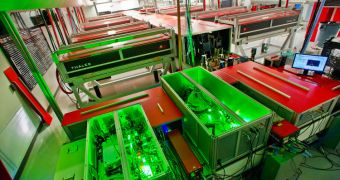American researchers announce the completion of a laser that is able to deliver a peak power of one quadrillion watts (one petawatt) every second. This is a world record in laser performances, and marks an important achievement for a new accelerator facility.
The instrument in question is the drive laser system of the Berkeley Lab Laser Accelerator (BELLA), which is currently being assembled at the US Department of Energy's (DOE) Lawrence Berkeley National Laboratory. Final work on the project is scheduled to be concluded soon.
According to physicists at the lab, the laser delivered its first petawatt light pulse on the night of July 20. The pulse was extremely short, lasting for just 40 femtoseconds (quadrillionths, or millionths of one billionth of a second).
The light beams were emitted at a rate of one Hertz. This means that one femtosecond laser pulse was released each second. Given the amount of power the instrument unleashes, this level of performance is truly outstanding, investigators say.
“This represents a new world record,” says the person who first conceived BELLA, Wim Leemans. He is the leader of the Lasers and Optical Accelerator Systems Integrated Studies program (LOASIS), at the Berkeley Lab Accelerator and Fusion Research Division (AFRD).
“My congratulations to the BELLA team for this early mark of success. This is encouraging progress toward a future generation of smaller and far more efficient accelerators to maintain our nation’s leadership in the tools of basic science,” adds Berkeley Lab director, Paul Alivisatos.
BELLA became a reality in record time. Leemans first proposed the project in 2006 and now, just 6 years later, the finishing touches are being put on the design. “It doesn’t seem that long ago that BELLA was just a dream, and now there is even more to look forward to,” AFRD director Stephen Gourlay adds.
Primarily, the accelerator will be used to study the physics of laser and matter interactions, Leemans explains.
“The laser’s peak power will give us access to new regimes, such as developing compact particle accelerators for high-energy physics, and tabletop free electron lasers for investigating materials and biological systems,” the researcher concludes.

 14 DAY TRIAL //
14 DAY TRIAL //